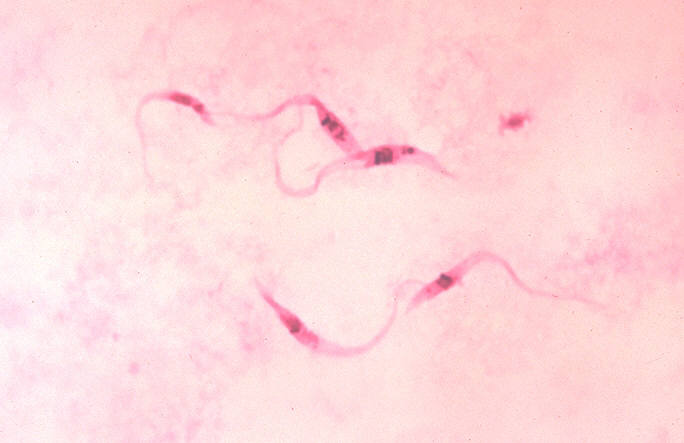- Trypanosoma
Taxobox
color = khaki
name = "Trypanosoma"

image_caption = "Trypanosoma cruzi ", crithidia.
domain = Eukaryota
unranked_phylum =Excavata
phylum =Euglenozoa
classis =Kinetoplastida
ordo =Trypanosomatida
genus = "Trypanosoma"
genus_authority = Gruby, 1843"Trypanosoma" are of the class kinetoplastida, a
monophyletic cite journal |author=Hamilton PB, Stevens JR, Gaunt MW, Gidley J, Gibson WC |title=Trypanosomes are monophyletic: evidence from genes for glyceraldehyde phosphate dehydrogenase and small subunit ribosomal RNA |journal=Int. J. Parasitol. |volume=34 |issue=12 |pages=1393–404 |year=2004 |pmid=15542100 |doi=10.1016/j.ijpara.2004.08.011 |url=http://linkinghub.elsevier.com/retrieve/pii/S0020-7519(04)00189-4] group of unicellular parasiticprotozoa . The name is derived from the Greek "trypaô" (boring) and "soma" (body) because of their corkscrew-like motion. Trypanosomes infect a variety of hosts and cause various disease, including the fatal diseasesleeping sickness in humans.Trypanosoma undergo a complex lifecycle which includes several different morphological forms. For example, "
Trypanosoma brucei " is transmitted between mammalian hosts through atsetse fly vector and undergoes a series of morphological and metabolic changes to adapt to these very different environments.Characteristic of this order is the mitochondrial genome, known as the
kinetoplast . It is made up of a highly complex series of catenatated circles and minicircles and require a cohort of proteins for organisation during cell division.Trypanosomes have a number of biologically interesting features that has made them the object of study. For example, trypanosomes do their genetic regulation post-transcriptionally, are a classic model of antigenic variation, and edit their mitochondrial mRNA transcripts using short guide RNAs encoded in mitochondrial minicircles as templates. In addition, two life cycle forms of "
Trypanosoma brucei " are easy to culture and are genetically pliable.Species of "Trypanosoma" include the following:
*"T. avium", which causestrypanosomiasis in birds
*"T. boissoni", inelasmobranch
*"T. brucei", which causessleeping sickness in humans andnagana in cattle
*"T. carassii", in freshwaterteleost s
*"T. cruzi", which causesChagas disease in humans
*"T. congolense", which causesnagana in cattle, horses, and camels
*"T. equinum", inSouth American horses, transmitted viaTabanidae ,
*"T. equiperdum", which causesdourine orCovering sickness inhorse s and otherEquidae
*"T. evansi", which causes one form of the diseasesurra in certain animals (a single case report of human infection in2005 in India [cite journal |author= |title=A new form of human trypanosomiasis in India. Description of the first human case in the world caused by Trypanosoma evansi |journal=Wkly. Epidemiol. Rec. |volume=80 |issue=7 |pages=62–3 |year=2005 |pmid=15771199 |doi=] was successfully treated withsuramin [cite journal |author=Joshi PP, Chaudhari A, Shegokar VR, "et al" |title=Treatment and follow-up of the first case of human trypanosomiasis caused by Trypanosoma evansi in India |journal=Trans. R. Soc. Trop. Med. Hyg. |volume=100 |issue=10 |pages=989–91 |year=2006 |pmid=16455122 |doi=10.1016/j.trstmh.2005.11.003 |url=http://linkinghub.elsevier.com/retrieve/pii/S0035-9203(05)00429-3] )
*"T. hosei" inamphibian s
*"T. levisi", in rats
*"T. melophagium", in sheep, transmitted via "Melophagus ovinus "
*"T. parroti", in amphibians
*"T. percae", in the fish species "Perca fluviatilis "
*"T. rangeli", believed to be nonpathogenic to humans
*"T. rotatorium", in amphibians
*"T. rugosae", in amphibians
*"T. sergenti", in amphibians
*"T. simiae", which causesnagana in animals
*"T. sinipercae", in fishes
*"T. suis", which causes a different form ofsurra
*"T. theileri", a large trypanosome infecting ruminants
*"T. triglae", in marineteleost s
*"T. vivax", which causes the diseasenagana References
#
- "Report on Trypanosomes", Thomas, (London, 1905)
# "Tropical diseases", Sir Patrick Manson, (fifth edition, London, 1914)
# "Tropical Medicine and Hygiene", C. W. Daniels, (New York, 1914)
#- "Report on Trypanosomes", Thomas, (London, 1905)
Wikimedia Foundation. 2010.
